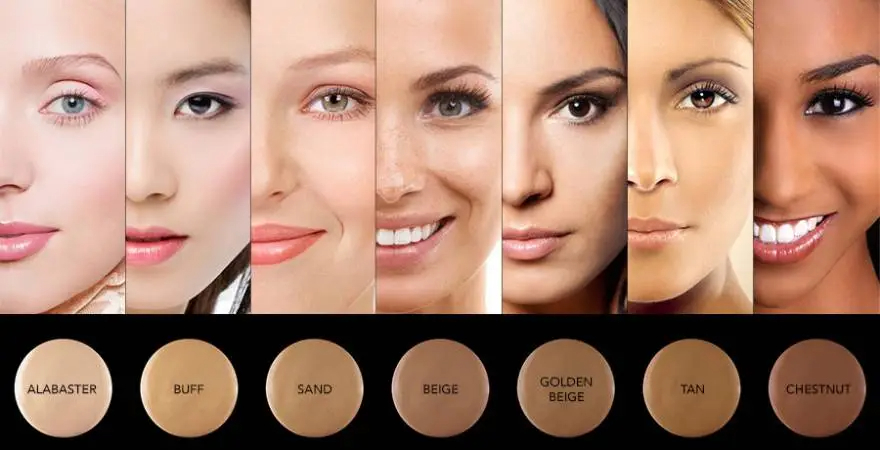Are you tired of mismatched foundation mishaps that leave you resembling a porcelain doll or, worse, an orange clown? Fear not! This comprehensive guide will unravel the mystery of your skin tone, ensuring your makeup game is on point every time.
What Is the Difference Between Skin Tone and Skin Undertone?
The distinction between skin tone and skin undertone can make or break your makeup look. The two may sound similar, but understanding that they are not the same will make finding your ideal shade much easier.
The skin tone is the surface of the skin, which can change when exposed to too much sun or suffering from hyperpigmentation. Skin undertone, on the other hand, is a subtle hue found beneath the skin.
The undertone remains constant regardless of how pale you become in the winter or how tanned you become in the summer. Skin tones range from dark to light, with an emphasis on overall colour. A skin undertone is a shade that exists within the skin tone. Warm, cool, and neutral are the three traditional undertones.
Identifying Your Skin Tone
Your skin tone, the first thing you notice in the mirror, dictates your pigmentation level.
- Fair Skin Color: Very fair, prone to burning, often with light or red hair.
- Light Skin Color: Generally light, with yellow or beige undertones that tan easily.
- Medium Skin Color: A medium complexion, possibly with olive undertones.
- Dark (Deep) Skin Color: A deep complexion, resistant to burning.
Surface colour may fluctuate due to factors like tanning, redness, or dryness, but diligent skincare and makeup can maintain consistency.
You try to maintain consistency by taking good care of your skin and concealing or smoothing out flaws with makeup.
The more the skin is exposed to UV rays, the more it adapts by producing more melanin to protect itself from the sun’s rays. As a result, skin tones differ depending on your genetic makeup and where your ancestors lived. The varying skin tones are caused by the climates and sunny regions to which the skin has to adapt. Africa, India, and the Middle East have the darkest skin tones due to the sun’s harshness.
The Influence of UV Rays on Skin Tone
The skin’s adaptation to UV rays is crucial in determining its tone. Melanin production increases with sun exposure, leading to varying skin tones based on genetic makeup and ancestral regions.
Aging and Changes in Skin Tone
As we age, the outer layer of the skin thins, affecting its shade. Melanocyte reduction prompts a shift to a thinner, paler appearance. Embrace these changes gracefully with makeup that complements your evolving skin.
Methods to Determine Surface Color
- Jawline Color: Less affected by changes, it’s a reliable indicator.
- Observations by Others: Others’ perceptions can align with your actual skin tone.
- Beauty Shop Matching Tests: Professional tests in beauty shops can provide accurate results in minutes.
Unveiling Undertones
Understanding undertones is crucial for perfecting your makeup routine. Undertones fall into three categories:
- Warm Undertones: Think yellow, peachy, and golden.
- Cool Undertones: Think red, pink, and bluish.
- Neutral Undertones: A blend of warm and cool hues.
Why Undertones Matter
Undertones play a pivotal role in choosing the right makeup shades. Aligning all your products with the same undertone ensures a cohesive and natural appearance, free from foundation lines and mismatched tones.
Strategies to Identify Your Undertone
- Check Your Veins: Bluish-purple, greenish, or a mix signals cool, warm, or neutral undertones.
- Sun Reaction: Tan or burn? Your reaction to the sun reveals warm or cool undertones.
- Blush Test: Blushing easily? You likely have cool undertones.
- Colour Preferences: Your affinity for specific colours indicates undertones.
- White Test: Assess your complexion against white. Dullness suggests warm undertones.
Additional Clues for Undertones
- Jewelry Preference: Silver or gold? Cools shine in silver, warm in gold.
- Eye Color: Warm-toned eyes include golden brown, green, and hazel with gold flecks.
- Behind the Ears: Yellowish, pink, or rosy hues reveal warm, cool, or neutral undertones.
- Basic Color Test: Cool shades prefer stark black and white, while warm tones lean towards off-whites.
Generalizations About Undertones by Skin Color Types
Understanding undertones becomes easier when considering general skin colour types:
- Fair Skin: Freckles, sensitivity, cool or warm undertones.
- Light Skin: Sunburn that turns to tan, spotty redness, both cool and warm undertones possible.
- Medium Skin: Rare burning, often warm undertones or “olive” skin with warm or neutral undertones.
- Dark Skin: Rarely burns, usually warm undertones, common in African Americans and women of Indian descent.
- Very Dark Types: Often described as “ebony” or “deep,” with warm or cool undertones.
Conclusion
Embrace your unique skin tone and undertones. Whether warm, cool, or neutral, the world of makeup awaits to enhance your natural beauty. Remember, the key to flawless makeup lies in understanding the canvas it adorns—your skin.
FAQs
- Does skin tone change with age?
- Yes, as the outer skin layer thins and melanocytes decrease, prompting a shift in shade.
- Why do undertones matter in makeup?
- Undertones guide the selection of makeup shades, ensuring a cohesive and natural look.
- How do I determine my skin’s undertone?
- Check veins, observe sun reactions, note color preferences, and try the white test.
- Can undertones affect jewelry choices?
- Yes, silver suits cool undertones, while gold complements warm undertones.
- Are undertones the same for all skin colors?
- No, undertones vary across skin colors, influencing the choice of makeup shades.
